Want to know something really transformative for businesses today? HRIS, or Human Resources Information Systems. Imagine you're a company trying to keep track of all your employees, their information, payroll, hiring processes, and more. Traditionally, this could get pretty messy. But with HRIS, everything changes.
So, what exactly is HRIS? Think of it as a powerful software tool that brings all your employee data into one place. It doesn't just store information—it organizes, processes, and helps you make sense of it all. This system has become absolutely essential for HR departments. It's like having an organized digital brain that helps HR professionals manage everything from recruitment and payroll to employee self-service portals.
Why is HRIS such a big deal? For starters, it automates many tedious HR tasks. No more manual data entry or hunting for files. Everything you need is at your fingertips, making the whole process more efficient. Plus, it supports better decision-making. With all your data neatly organized, you can analyze trends, make data-driven decisions, and improve your overall HR strategy.
In our chat today, we'll break down the key functions of HRIS, look at the benefits of using it, and give some tips on how to choose the best system for your company. We'll also talk about how to implement HRIS effectively and share some strategies to get the most out of it. And just for fun, we'll take a peek into the future to see where HRIS technology is headed.
By the end of this, you'll have a solid understanding of how HRIS can revolutionize your HR practices. Ready to dive in?
Table of Contents
- 1. What is HRIS
- 2. HRIS vs. HRMS vs. HCM
- 3. Core Functions of an HRIS
- 4. Benefits of Implementing an HRIS
- 5. Choosing the Right HRIS
- 6. HRIS Implementation Process
- 7. Maximizing the Value of Your HRIS
- 8. Future Trends in HRIS Technology
- 9. Conclusion
- 10. FAQs
What is HRIS
HRIS, an acronym for Human Resource Information System, serves as a comprehensive software solution designed to meet the core HR needs of businesses, thereby enhancing productivity. This system is pivotal in maintaining, managing, and processing detailed employee information alongside human resources-related policies and procedures. With its advent, HRIS has significantly streamlined interactions between employees and organizations, allowing HR professionals to focus on more strategic and high-value tasks.
Key Features and Users of HRIS:
Features:
- Employee Data Management
- Recruitment and Onboarding
- Payroll Processing
- Time and Attendance Management
- Benefits Administration
- Compliance and Reporting
- Analytics and Reports
- Self-Service for Employees
Users:
- HR Administrators
- Payroll Specialists
- Talent Management Specialists
- Recruiters
Challenges and Cloud Benefits:
Challenges:
- Ensuring data privacy and security
- Adhering to regulations and compliance
- Minimizing business disruption during implementation
Cloud Benefits:
- Easy scalability to match business growth
- Greater control over operational vs. capital expenditures
- Quick and easy access to innovation, enhancing operational efficiency
By integrating HRIS into their operations, organizations can reap benefits such as improved record-keeping, enhanced compliance with regulations, and efficiency in HR processes. The system supports core HR processes like payroll processing, benefits administration, and employee self-service, making it crucial for operational efficiency and strategic planning.
HRIS vs. HRMS vs. HCM
Understanding the distinctions between HRIS, HRMS, and HCM is crucial for organizations to select the right technology that aligns with their HR goals and needs. Here's a breakdown of these systems to clarify their functionalities and ideal use cases:
Now, there’s a bit of a mix-up that often happens. People sometimes use HRIS, HRMS, and HCM like they’re the same thing, but they’re not. HRMS (Human Resource Management System) and HCM (Human Capital Management) are actually a bit more advanced. They come with extra features for things like talent and performance management. So, depending on what your company needs—whether it’s just the basics or something more comprehensive—you can choose the system that fits best.
We actually have a blog that dives deep into the differences between HRIS, HRMS, and HCM. It's super informative and can really help you figure out which one fits your organization best. You should definitely check it out to get a clearer picture.
Core Functions of an HRIS
HRIS systems are packed with features that make HR tasks a breeze, boost how you manage data, and overall, just make your organization run smoother. You can think of these systems as being categorized by what they can do and which HR tasks they support.
Basic HR Functions:
- Employee Data Management: Centralizes all employee information, including demographics, employment history, job roles, and tax withholdings, ensuring easy access and management.
- Payroll Processing: Automates pay schedules, integrates time and attendance data, and allows for self-entered leave information, simplifying the payroll process.
- Benefits Administration: Offers self-service options for employees to manage their benefits, enhancing employee engagement and satisfaction.
- Time Tracking and Leave Management: Facilitates accurate time tracking and efficient management of leave requests, promoting self-sufficiency among employees.
- Performance Management: Supports goal setting, self-assessments, and feedback through surveys, fostering a culture of continuous improvement and participation.
- Recruiting and Onboarding: Streamlines the recruitment process, from posting jobs to processing new hires, ensuring a smooth transition for candidates into the organization.
Advanced HR Functions:
- Training and Development: Tracks employee qualifications and integrates with Learning Management Systems (LMS) to support ongoing employee development.
- Compensation Management: Manages salary structures and benefits packages, aligning compensation strategies with organizational goals.
- Analytics and Reporting: Provides comprehensive reporting tools and customizable dashboards for insightful HR analytics, aiding in strategic decision-making.
Operational Benefits:
- Reduced Paperwork: Eliminates the need for paper files by storing all employee data in a centralized repository, improving data accuracy and accessibility.
- Compliance and Security: Ensures adherence to regulatory requirements and secures sensitive employee data, mitigating legal risks.
- Integration and Scalability: Seamlessly integrates with other business systems and scales according to organizational growth, ensuring long-term viability.
So, basically, HRIS systems are like the ultimate toolkit for handling everything HR-related, from the basic admin stuff to more strategic projects. Using these systems, companies can work more efficiently, stay on top of compliance, and create a better experience for employees.
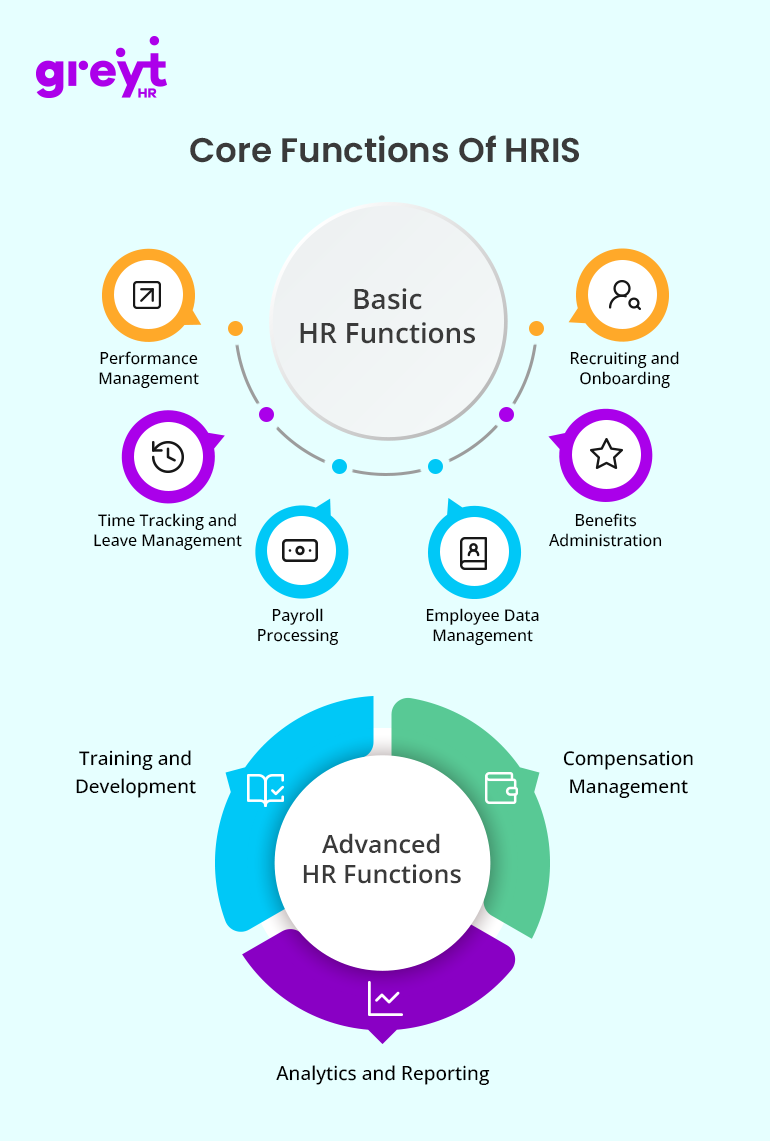
Benefits of Implementing an HRIS
You know, bringing an HRIS into a company can really change the game for how HR departments and employees work every day. The perks are huge, from making daily tasks run smoother to boosting strategic planning. Honestly, HRIS is a must-have for modern HR management.
Operational and Efficiency Benefits:
- Expedited Tasks and Reduced Paperwork: HRIS software significantly speeds up HR-related tasks and diminishes the reliance on physical paperwork, making processes more efficient and eco-friendly.
- Automated HR Workflows: From onboarding to benefits administration, HRIS can automate repetitive tasks, freeing up HR professionals to focus on more strategic initiatives.
- Real-Time Data Access and Version Control: Authorized users gain access to up-to-date information, ensuring that everyone is working with the latest data. This is particularly useful for managing document versions and syncing changes across the organization.
- Cost Savings: Through centralization of data, automation, and streamlined processes, organizations can achieve significant cost reductions.
- Compliance and Security: Built-in compliance features and enhanced data security protocols help businesses adhere to industry regulations and protect sensitive employee information.
Strategic and Employee-Centric Benefits:
- Data-Driven Decision Making: HRIS provides comprehensive and accurate insights, enabling HR managers to make informed decisions that align with the overall business strategy.
- Enhanced Employee Experience: Employees can self-manage their personal information, benefits, and leave requests, fostering a culture of empowerment and engagement.
- Scalability and Strategic Support: As organizations grow, HRIS can adapt to changing needs, adding modules and features that support more strategic HR functions. This scalability ensures that HRIS remains a valuable tool for both operational efficiency and strategic planning.
Innovation and Future-Proofing:
- Cloud-Based Advantages: Cloud-based HRIS solutions offer scalability, cost savings, and reduced IT support needs compared to traditional on-premise systems.
- Continuous Improvement: Customers benefit from routine updates and the addition of …new features over time, which can improve system performance and user experience.
- Preparation for Future Needs: With the ability to add modules as needed, HRIS systems are not just about managing the present but are also an investment in the organization's future, ensuring readiness for more complex, interconnected workforce demands.
These benefits show how an HRIS isn’t just about making HR tasks easier—it’s a key part of boosting overall company goals too. With an HRIS, companies can handle the complexities of modern HR management more smoothly and efficiently, setting themselves up for success in today’s fast-changing business world.
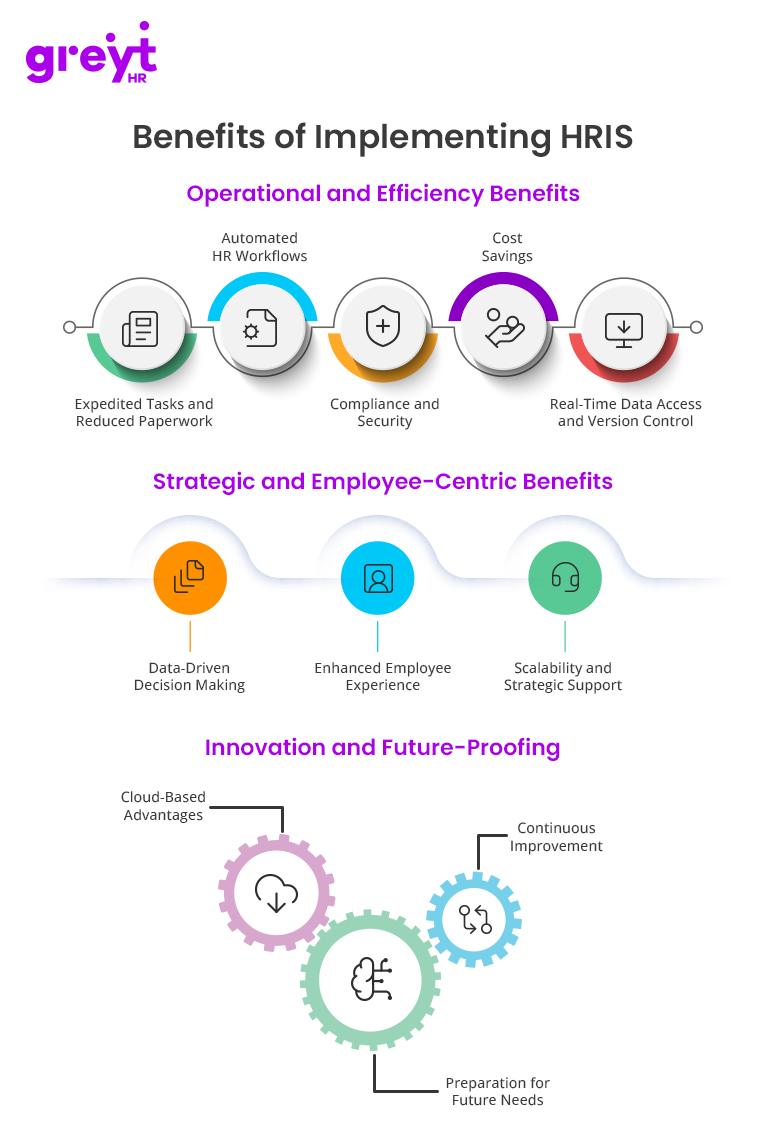
Choosing the Right HRIS
Picking the right HRIS for your company is all about really understanding what you need now and what you'll need down the line. Plus, you’ve got to know what’s out there in the market. Here are some steps and things to think about to help you make the best choice:
Identifying HRIS Needs and Setting Goals
- Assessment of Current and Future Needs: Clearly define what your organization aims to achieve with the new HRIS. Consider integration with existing systems like ATS and payroll, and identify limitations of the current HRIS setup.
- Strategic Alignment: Ensure the chosen HRIS aligns with the organization's strategic plans and the HR department's responsibilities, including payroll, recruiting, and benefits administration.
- Feature Requirements: Distinguish between essential features and desirable additions. Common modules include recruiting, benefits administration, payroll, and employee self-service (ESS).
Selection Process
Research and Request for Proposal (RFP):
- Begin with research, connecting with industry peers and reviewing HR blogs for recommended vendors.
- Send out a detailed RFP to shortlisted vendors to gather information on their offerings.
System Evaluation:
- Organize a project committee beyond the HR department to evaluate the systems.
- Develop a spreadsheet-rating matrix to compare the offerings and limitations of each product.
- Schedule demonstrations with vendors and create a checklist to ensure all important aspects are covered.
Decision Making:
- Evaluate the service provided during the RFP and demonstration process.
- Conduct reference checks and, if possible, onsite visits to see the system in action.
- Secure a service contract that includes ongoing maintenance, updates, and compatibility assurances.
Market Offerings and Trends
Popular HRIS Solutions: Leading HR tech providers, like greytHR, offer intuitive, cloud-based platforms and a range of allied services.
Emerging Needs and Preferences:
- Organizations are looking for user-friendly systems, with a significant percentage considering changes for better ease of use.
- There's a growing demand for integrated HR software that supports real-time decision-making and comprehensive analytics for talent acquisition and training.
In a nutshell, choosing the right HRIS is a big deal that needs some thoughtful planning and consideration of what you need now and in the future. By following a clear selection process and staying updated on the latest trends, you can make a smart choice that fits your organization perfectly.
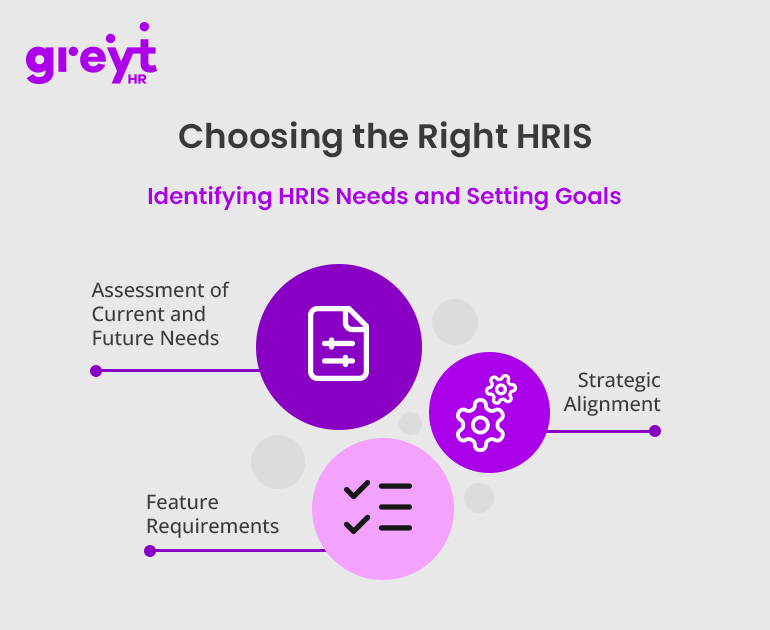
HRIS Implementation Process
Successfully implementing an HRIS takes a structured approach that fits your business goals and unique needs. Here’s a breakdown of the six key steps to ensure a smooth transition and get the most out of your HRIS:
Search: Start by analyzing your organization's specific needs. Look at your current processes and think about what you'll need in the future. Identify which HR tasks need automation and pinpoint any pain points in your existing system.
Plan and Align: Make sure your HRIS aligns with your company's overall goals. Get input from key people across different departments like payroll, talent acquisition, HR, training, IT, and operations. Create a project timeline and define clear objectives.
Define and Design: Configure workflows, processes, security settings, and forms to fit your company's needs. Think about system scalability, compliance requirements, and long-term HR goals. Identify gaps or inefficiencies in your current HR processes that the HRIS can fix.
Configure and Test: Build out the workflows and test the system thoroughly. Get feedback from the project team and other employees, especially those who might be more resistant to change. Ensure data integrity during migration and set up strong data security measures.
Train and Communicate: Develop training programs tailored to different employee roles to make the transition smoother. Offer ongoing training to keep everyone updated on new features. Designate 'change champions' within your organization to promote the HRIS and show its benefits.
Deploy and Sustain: Roll out the HRIS and start enjoying the benefits. Keep communication channels open for feedback from users. Make sure employees are well-prepared to use the system and regularly assess the HRIS to ensure it meets your evolving needs.
Throughout this process, keep communication open, involve stakeholders at all levels, and prioritize security and compliance. By following these steps, you can handle the complexities of HRIS implementation and ensure the system meets both your current and future needs.
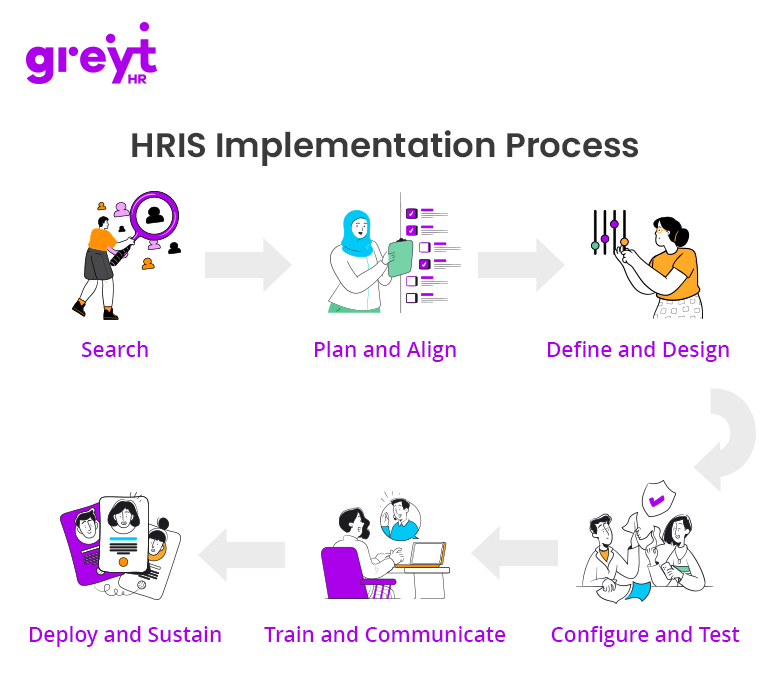
Maximizing the Value of Your HRIS
Hey, let's talk about how to make the most out of your HRIS. It's not just about having the HRIS system—it's about managing and using it strategically. Here are some key practices to get the most bang for your buck:
Customization and Regular Updates
- Customize for Your Needs: Tailor the HRIS to fit exactly what your organization needs. Make sure it supports your specific HR processes and workflows.
- Stay Updated: Keep the system fresh with regular updates and maintenance. This keeps everything running smoothly and secure.
Data Management and Security
- Keep It Clean: Regularly check and clean up your HRIS data to ensure it's accurate and complete. This is crucial for making good decisions.
- Lock It Down: Implement strong security measures to protect sensitive employee info. Compliance is key here, and you want to avoid any data breaches.
Training, Support, and Performance Monitoring
- Train Up: Make sure everyone knows how to use the HRIS with comprehensive training programs and ongoing support. Good customer service is a must.
- Keep an Eye Out: Monitor how the HRIS is performing and look for ways to make it even better. You want it to be efficient and effective.
Feedback and Adaptation
- Listen Up: Actively seek feedback from users and use it to improve the system. This keeps everyone happy and the system useful.
- Be Flexible: Adapt the system as your organization evolves. What works today might not work tomorrow, so stay nimble.
Role of HRIS Analyst
- Consider Hiring: Think about bringing in an HRIS analyst to manage and analyze the system. They can provide valuable insights and keep things aligned with your business goals.
By following these practices, you can make sure your HRIS isn't just a tool—it's a strategic asset that drives success across your organization.
Future Trends in HRIS Technology
Let's dive into what's coming next in HRIS technology. It's evolving fast, thanks to things like artificial intelligence, analytics, and the growing importance of mobile and social connections. These trends aren't just changing how HRIS works—they're also making things better for employees and more efficient for companies.
Artificial Intelligence and Analytics:
- AI-Powered HRIS: AI is changing the game by analyzing data, making predictions, and automating routine HR tasks. It's great at spotting patterns in employee data, predicting who might leave the company, and suggesting personalized learning opportunities.
- Predictive Analytics: HRIS with advanced analytics can help companies make data-driven decisions about their workforce. They can identify top performers, predict where there might be skill gaps, and even forecast who might leave the company.
- AI Recruitment and Compliance: AI is making the hiring process smoother with Applicant Tracking Systems. These systems help candidates from applying to getting onboarded, and they make sure companies stay compliant with regulations.
Mobile and Cloud-Based Solutions:
- Mobile-Friendly HRIS: More and more HRIS are designed for mobile devices. This means employees can do things like track their time, sign documents, and do performance reviews on the go.
- Cloud-Based HRIS: Cloud-based HRIS platforms are becoming popular because they're cheaper, easier to scale, more secure, and make it easier for employees to collaborate and access data from anywhere.
Employee Experience and Security:
- Self-Service Features: Giving employees access to their HR info, like benefits and payroll, is key for a better employee experience.
- Cybersecurity: With AI and the cloud in the mix, HR teams need to stay on top of updating their HRIS and making sure they're following cybersecurity best practices to keep employee data safe.
These trends show how HRIS is shaping the future of HR management. By embracing AI, mobile-friendly designs, cloud-based solutions, and focusing on improving the employee experience and data security, companies can use HRIS to make things more efficient, make better decisions, and keep their workforce engaged and happy.
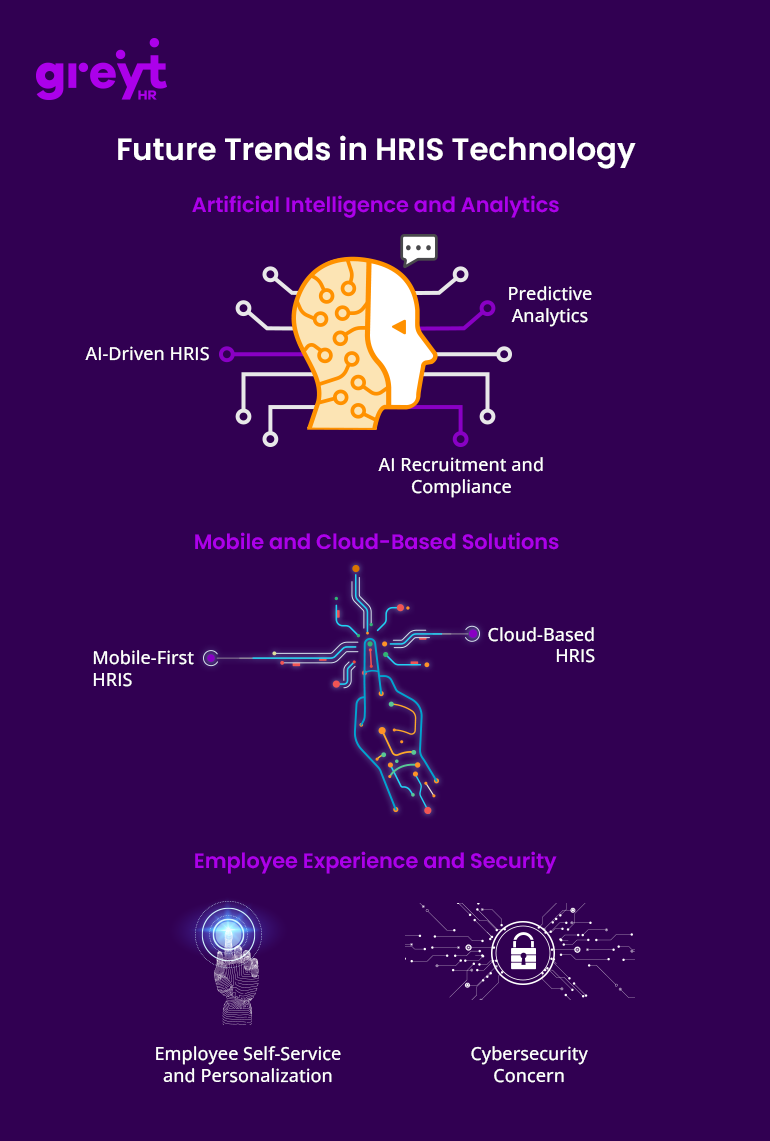
Conclusion
Now that we know everything about HRIS, it's clear it's a game-changer in HR management. It streamlines operations, boosts efficiency, and helps with big-picture decision-making. With fancy stuff like AI and cloud solutions, HRIS is at the forefront of making companies run better and giving employees a great experience. Using HRIS isn't just about making HR tasks easier—it's about hitting those big organizational goals and setting up for future growth.
In today's ever-changing business world, picking, implementing, and maximizing the right HRIS is key. Whether you're looking to revamp HR processes, make smarter decisions with data, or keep your workforce happy, HRIS is the way to go. And if you're serious about taking your HR game to the next level, considering greytHR-Industry's best HRM Software is a smart move. It's not just about ticking boxes—it's about using HRIS to drive your organization toward its vision and goals in this age of digital transformation.
FAQs
How does an HRIS enhance HR management?
An HRIS enhances HR management by offering analytics and insights on various employee-related data points, including turnover, retention, engagement, diversity, and skills. It aids in forecasting and budgeting for future HR requirements such as hiring, training, and compensation plans.
In what ways does an HRIS contribute to the efficient use of human resources?
An HRIS increases HR and organizational efficiency by leveraging technology to store, process, and manage employee information. This includes basic details like names and addresses, as well as more sensitive data such as national IDs or Social Security numbers, visa or work permit statuses, and dependent information.
What are the steps for a successful HRIS implementation?
To successfully implement an HRIS, follow these steps:
- Identify the company's needs.
- Determine the project's scope.
- Form a project committee.
- Conduct demos and request proposals (RFPs).
- Configure the system.
- Pilot the system.
- Train the workforce.
- Deploy the system.
How does an HRIS enhance reporting capabilities?
HRIS systems enhance reporting capabilities by improving data accuracy through advanced analytics and reporting features. They enable HR professionals to generate customized reports, monitor key performance indicators (KPIs), and analyze workforce trends, thereby facilitating informed decision-making.
Why is the importance of HRIS growing in businesses?
The importance of HRIS is growing because it simplifies HR tasks, reduces errors, and provides valuable data insights, making it easier for businesses to manage their workforce efficiently.
How do human resources and its importance affect company growth?
Human resources and its importance directly impact company growth by ensuring the right talent is hired, employees are engaged, and compliance with laws is maintained, driving overall business success.

